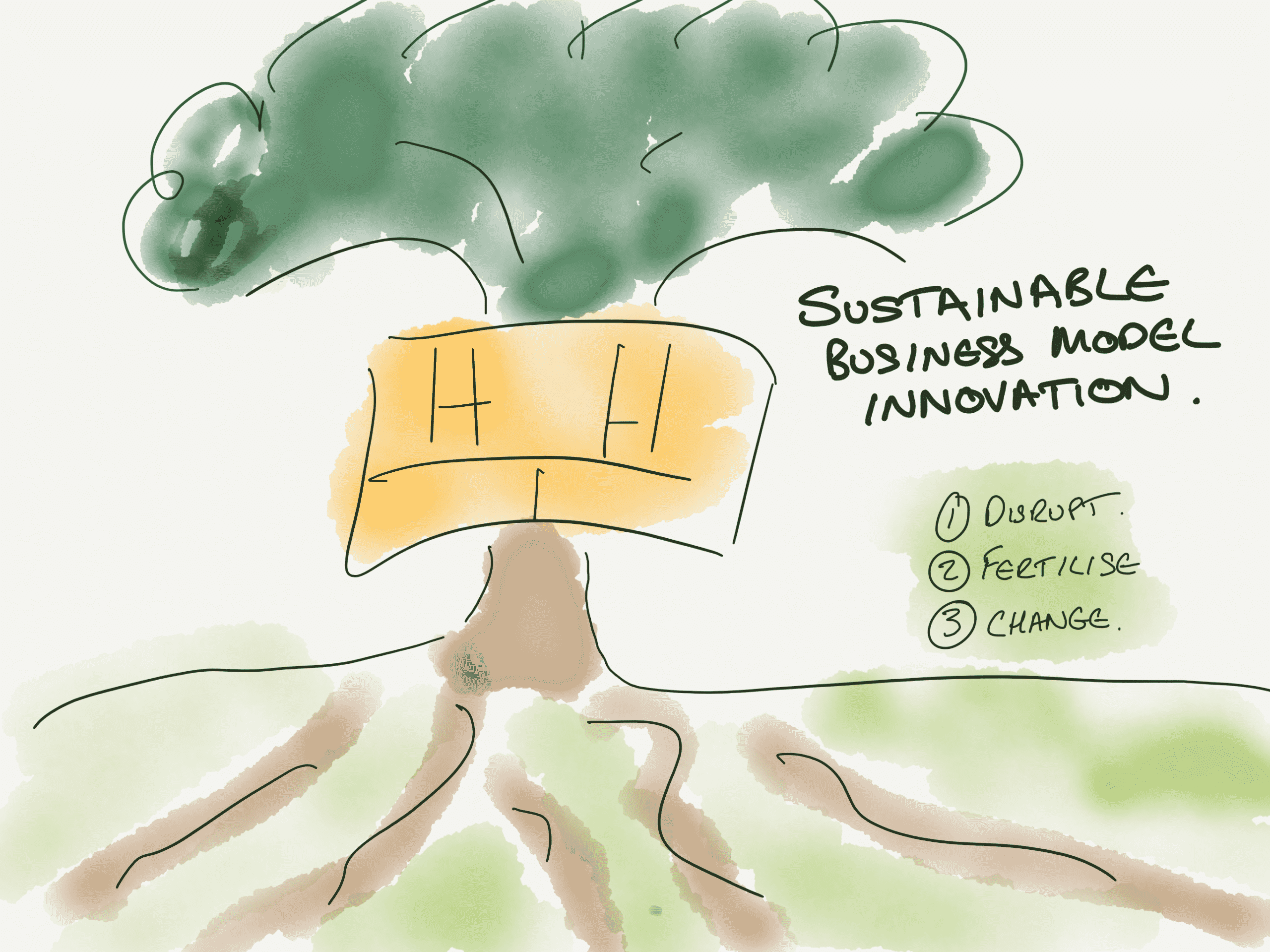Building Sustainable Business Models
Creating enterprises that thrive financially while generating positive environmental and social impact
The Business Case for Sustainability
The notion that sustainability initiatives come at the expense of profitability is increasingly being challenged by market evidence. Organizations that strategically integrate environmental, social, and governance (ESG) factors into their core business models are demonstrating superior performance across multiple metrics. According to a 2022 McKinsey study, companies with strong ESG ratings outperformed their peers by 10% on average in terms of equity returns over a five-year period.
At Al Mithaq Institute, we've observed that the most successful sustainable business models don't treat sustainability as a separate initiative but as a fundamental redesign of how value is created, delivered, and captured. This holistic approach transforms sustainability from a cost center to a driver of innovation and competitive advantage.
Key Insight: 73% of consumers worldwide are willing to pay more for products that guarantee transparency and sustainable practices throughout their supply chain.
Core Frameworks for Sustainable Business Models
Several frameworks have emerged to guide organizations in transitioning toward more sustainable business models. These structured approaches help businesses systematically reassess their operations through a sustainability lens.
Circular Economy Model
Replaces the traditional linear "take-make-dispose" approach with a closed-loop system where resources are kept in use for as long as possible. This model eliminates waste through the continual reuse of materials and regeneration of natural systems.
Shared Value Creation
Developed by Michael Porter and Mark Kramer, this model focuses on identifying and expanding the connections between societal and economic progress, creating economic value in ways that also produce value for society.
Triple Bottom Line
Measures success across three dimensions: economic prosperity, environmental quality, and social equity (People, Planet, Profit). This framework ensures businesses account for the full cost of their operations.
B Corp Certification
Provides a comprehensive framework for assessing and improving impact across five key areas: governance, workers, customers, community, and the environment, with transparent performance standards.
Key Elements of Sustainable Business Models
While sustainable business models vary significantly across industries, several common elements have emerged as critical for success:
1. Purpose-Driven Strategy
Sustainable business models are anchored in a clear organizational purpose that extends beyond financial returns. This purpose articulates how the company creates positive environmental and social impact alongside economic value. Companies like Patagonia demonstrate how an environmental mission can guide strategic decision-making, from product design to supply chain management. Their commitment to environmental activism hasn't hindered profitability; it has become a key differentiator in a crowded market.
2. Circular Value Chains
Linear value chains that extract resources, transform them into products, and ultimately create waste are being replaced by circular systems. These circular value chains design out waste and pollution, keep products and materials in use, and regenerate natural systems. Interface, a global carpet manufacturer, has pioneered circular economy principles through its ReEntry program, which reclaims and recycles old carpet tiles, reducing virgin material demand by over 60% and cutting production costs significantly.
3. Stakeholder-Inclusive Governance
Sustainable business models expand governance considerations beyond shareholders to include a broader range of stakeholders: employees, customers, suppliers, communities, and the environment. Companies like Natura &Co have formalized stakeholder governance by creating decision-making frameworks that explicitly consider impacts across these groups. Their stakeholder impact assessments have improved risk management and led to innovations in product development and community engagement initiatives.
Case Study: Unilever's Sustainable Living Plan
Unilever's comprehensive 10-year sustainability initiative demonstrated how integrating sustainability into the core business model can drive financial performance:
- Sustainable Living Brands grew 69% faster than the rest of the business
- €1.2 billion cost savings through eco-efficiency measures
- 92% reduction in waste per unit of production
- 33% reduction in water usage per consumer use
- Increased employee engagement scores by 12%
4. Regenerative Resource Use
Sustainable business models move beyond merely reducing harm to actively restoring and regenerating natural systems. This approach includes investing in biodiversity, watershed restoration, and carbon sequestration projects. Regenerative agriculture practices championed by companies like Danone not only reduce negative environmental impacts but actively improve soil health, water retention, and biodiversity. These practices create more resilient agricultural supply chains and often yield higher-quality raw materials with improved nutritional profiles.
5. Innovative Financing Mechanisms
New financing approaches like green bonds, sustainability-linked loans, and impact investing are providing capital specifically for sustainable business model innovation. These instruments often offer preferential terms for projects with measurable environmental and social benefits. For example, Enel, the Italian energy company, has issued over €14 billion in sustainability-linked bonds that tie interest rates to the company's achievement of renewable energy capacity targets, providing financial incentives for the transition to clean energy.
Implementation Strategy: A Four-Phase Approach
Transforming an existing business model or creating a new sustainable one requires a structured implementation approach. Based on our experience at Al Mithaq Institute, we recommend a four-phase strategy:
Phase 1: Assess and Envision
- Conduct a materiality assessment to identify the most significant environmental and social impacts of your current business model
- Map your value chain to identify sustainability hotspots and innovation opportunities
- Benchmark against industry leaders and identify best practices
- Develop a clear sustainability vision that aligns with your organizational purpose
- Define measurable sustainability goals with specific timeframes
Phase 2: Design and Innovate
- Apply sustainable design thinking to reimagine products, services, and processes
- Explore alternative revenue models (product-as-a-service, sharing platforms, etc.)
- Identify partnership opportunities across your value chain
- Develop sustainability metrics and impact measurement systems
- Create financial models that account for sustainability outcomes
Phase 3: Implement and Integrate
- Pilot initiatives in controlled environments to test assumptions
- Develop sustainable supply chain management systems
- Align employee incentives with sustainability objectives
- Integrate sustainability metrics into performance management
- Build sustainability capabilities through training and development
Phase 4: Scale and Optimize
- Scale successful pilots across the organization
- Communicate sustainability performance to stakeholders transparently
- Continuously optimize based on impact measurement data
- Engage in collaborative industry initiatives to drive systemic change
- Advocate for policy frameworks that support sustainable business models
Overcoming Common Barriers
Building sustainable business models comes with significant challenges. Here are strategies for addressing the most common barriers:
Short-Term Financial Pressures
Organizations often struggle to balance long-term sustainability investments with short-term financial expectations. This tension can be addressed by developing robust business cases that quantify the financial benefits of sustainability initiatives, including risk reduction, cost savings, and revenue opportunities. Phasing implementation to deliver quick wins alongside longer-term transformational projects can help maintain momentum while demonstrating value. Companies like Philips have successfully navigated this challenge by setting both short-term operational targets and long-term strategic sustainability goals, with clear connections to financial performance metrics.
Organizational Silos
Sustainability initiatives often fail when they're isolated within a single department rather than integrated across the organization. Breaking down these silos requires cross-functional governance structures, shared performance metrics, and collaborative innovation processes. Siemens addressed this challenge by creating sustainability business partners—specialists embedded within each business unit who collaborate with operational teams to implement the company's sustainability strategy. This approach has accelerated the integration of sustainability principles into core business processes and decision-making.
Skills and Knowledge Gaps
Many organizations lack the specialized knowledge required to implement sustainable business model innovations effectively. Investing in capability building through training, hiring specialized talent, and establishing knowledge-sharing platforms can address this barrier. L'Oréal's sustainability training programs reach all 86,000+ employees and are tailored to different functions, from marketing to R&D, ensuring that sustainability principles are applied consistently across the organization. Their dedicated sustainable innovation lab also provides specialized technical expertise to product development teams.
Al Mithaq Institute's Sustainable Business Model Services
As a leading educational institution in Dubai, Al Mithaq Institute offers specialized training and consultancy services to help organizations develop and implement sustainable business models that align with both global sustainability frameworks and regional priorities.
Our programs combine cutting-edge research with practical implementation tools, helping organizations navigate the complex transition to more sustainable operations while maintaining competitive advantage in rapidly evolving markets.
The Future of Sustainable Business Models
Several emerging trends are shaping the next generation of sustainable business models:
Regenerative Business
Moving beyond sustainability's "do less harm" approach, regenerative business models actively restore and enhance natural and social systems. This approach involves designing products and operations that sequester carbon, build soil health, enhance biodiversity, and strengthen communities. Regenerative models like those pioneered by Guayaki Yerba Mate don't just sustain resources but actively improve ecosystems through their business operations, creating a net positive impact.
Digital Enablement
Advanced technologies are creating new possibilities for sustainable business models. Blockchain enables transparent supply chain tracking, AI optimizes resource use, and IoT facilitates product-as-a-service models through continuous monitoring. Digital platforms are also enabling shared resource utilization, extending product lifespans, and creating new markets for recycled materials. Companies like Winnow are using AI and computer vision to help commercial kitchens reduce food waste by up to 70% while cutting costs by 2-8% through real-time waste monitoring and analysis.
Systems Change Collaboration
Leading organizations are recognizing that many sustainability challenges cannot be solved by individual companies alone. Cross-industry collaborations, pre-competitive partnerships, and multi-stakeholder initiatives are emerging to address systemic challenges. The Ellen MacArthur Foundation's Plastics Pact brings together businesses, governments, and NGOs to create circular economy solutions for plastic packaging. By collectively establishing industry standards, sharing best practices, and coordinating investments in recycling infrastructure, these collaborations can achieve system-wide transformation that would be impossible for individual actors.
Conclusion
Building sustainable business models is no longer optional in a world facing urgent environmental and social challenges. Forward-thinking organizations are demonstrating that well-designed sustainable business models can deliver superior financial returns while creating positive impact for a broader range of stakeholders.
The transition to sustainable business models requires reimagining how value is created, delivered, and captured. This process demands strategic vision, innovative thinking, and systematic implementation. Organizations that successfully navigate this transformation will be better positioned to thrive in a rapidly changing business landscape where sustainability performance is increasingly tied to market success.
By adopting the frameworks, strategies, and implementation approaches outlined in this article, organizations can build business models that generate lasting value for shareholders, society, and the environment. The result is not just a more sustainable business, but one that is more resilient, innovative, and aligned with the demands of an evolving global marketplace.
Frequently Asked Questions
How can small businesses implement sustainable business models with limited resources?
Small businesses can start with focused initiatives that align with their core competencies and directly impact their most material sustainability issues. Begin by identifying low-hanging fruit like energy efficiency improvements or waste reduction that offer quick returns on investment. Leverage industry associations and sustainability networks that provide resources specifically for small businesses. Consider a phased approach, starting with changes that require minimal capital investment but yield measurable benefits in both sustainability performance and cost reduction.
How do you measure the success of a sustainable business model?
Effective measurement combines financial metrics with environmental and social impact indicators. Start by establishing a baseline of your current performance and setting clear, science-based targets. Implement a balanced scorecard approach that tracks progress across multiple dimensions: revenue growth from sustainable products, resource efficiency improvements, carbon emissions reduction, diversity and inclusion metrics, and stakeholder satisfaction scores. Align with recognized frameworks like the Global Reporting Initiative (GRI) or Sustainability Accounting Standards Board (SASB) for standardized reporting that enables benchmarking.
What are the most common pitfalls when implementing sustainable business models?
Common pitfalls include treating sustainability as separate from core business strategy, setting vague goals without clear metrics, failing to secure leadership commitment, underestimating implementation costs, and neglecting to engage employees across the organization. Another major pitfall is "greenwashing"—making superficial sustainability claims without substantive changes to the business model. Successful implementation requires genuine integration of sustainability principles into strategic decision-making, operations, and organizational culture, backed by transparent reporting and accountability mechanisms.
How do sustainable business models adapt to regional differences, particularly in the Middle East?
Effective sustainable business models consider regional environmental priorities, regulatory landscapes, cultural values, and market dynamics. In the Middle East, key considerations include water scarcity, energy transition in oil-dependent economies, and alignment with national vision programs like UAE Vision 2021 and Saudi Vision 2030. Successful adaptation involves engaging with local stakeholders, understanding regional sustainability challenges, and aligning sustainability initiatives with local development priorities while maintaining global best practices and standards.







